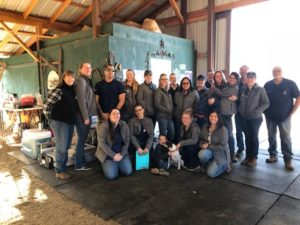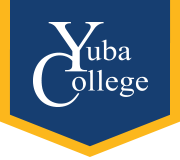
VETT 1 Introduction to Veterinary Technology (3 units) CSU
This course introduces the first year Veterinary Technology student to the diverse field of veterinary technology. Emphasis on careers and career paths, legal applications, ethical responsibilities, professional attitudes, animal breeds, physical restraint, medical terminology, and occupational safety issues. Prerequisite: Admission to the Veterinary Technology Program. (L)
VETT 2 Veterinary Physiology and Anatomy (3 units) CSU
Gross anatomy and physiology of domestic animals. Includes the study of body systems such as skeletal, muscular, integumentary, special sense organs, circulatory and digestive. Also includes principles of certain pathological problems and surgical conditions. Prerequisite: VETT 1 or equivalent. (LM)
VETT 2A Veterinary Anatomy Laboratory (2 units) CSU
Gross anatomy laboratory of domestic animals. Includes the study of body systems such as skeletal, muscular, integumentary, special sense organs, circulatory and digestive. The structure and function of the animal body with emphasis on the similarities and differences among domestic animals. Prerequisite: Concurrent enrollment in VETT 2. (L)
VETT 3 Pharmacology for Veterinary Technicians (3 units) CSU
Concepts of veterinary pharmacology. Appropriate pharmacological agents are discussed including classification, dosage, method of action, method of administration, dispensing procedures, legal requirements and pharmacy management. (LM)
VETT 4 Clinical Laboratory Techniques (3 units) CSU
Studies of the techniques and procedures employed in evaluating clinical diagnostic samples. Emphasis will be on procedures common to veterinary medicine including hematology, serum chemistry, urinalysis, cytology, immunology and microbiology. Topics include: the safe and proper collection of diverse samples, microbial culturing, methods of sample analysis, and the significance of normal and abnormal results. Prerequisite: VETT 1 or equivalent. (LM)
VETT 5A Veterinary Technology Internship (1-4 units) CSU
Off-campus practical clinical work experience for Veterinary Technology Program students in veterinary facilities supervised by licensed veterinarians and veterinary technicians. Integration into a veterinary health care team and exposure to varied methodologies and practice philosophies in a variety of clinical settings. Practical application of knowledge, skills, and attitudes acquired in the first year program course work: clinical application of anatomy and physiology; pharmacology and medical math; chemistry and microbiology; interpersonal skills and effective team building. Supervised hands-on training in basic medical nursing. Opportunity to practice and attain entry level competency in essential clinical skills. This course is intended for students admitted into the Veterinary Technology Program. Prerequisite: VETT 91 or equivalent. (LM)
VETT 5B Veterinary Technology Internship (1-4 units) CSU
Off-campus practical clinical work experience for Veterinary Technology Program students in veterinary facilities supervised by licensed veterinarians and veterinary technicians. Students begin to follow directions from doctors and staff with increasing independence and exhibit good judgment and critical thinking skills. Practical application of knowledge, skills, and attitudes acquired in the concurrent second year program course work: patient assessment skills, animal behavior, administration of medication and sample collection; assisting in radiology, clinical pathology, anesthesiology and common clinical procedures. Rotation through various facilities is required. Prerequisite: VETT 91 or equivalent. (LM)
VETT 5C Veterinary Technology Internship (1-4 units) CSU
Off-campus practical clinical work experience for Veterinary Technology Program students in veterinary facilities supervised by licensed veterinarians and veterinary technicians. Student assumes primary responsibility for training, mentoring, and supervising new unregistered veterinary assistants and veterinary technicians. High-level practical application of knowledge, skills, and attitudes acquired in the concurrent second year program course work. In addition to competently performing all essential clinical skills and duties delegated to the veterinary technician; the student will begin to take responsibility for client education, development of patient care plans, providing nursing care to critical care and emergency patients, performing advanced sampling techniques, conducting special diagnostic studies, and performing more complex therapeutics. Rotation through various facilities is required. Prerequisite: VETT 91 or equivalent. (LM)
VETT 5D Veterinary Technology Internship (1-4 units) CSU
Formal, structured off-campus clinical experience in licensed veterinary facilities, which serve as a means of instructing the student in practical, hands-on, clinical skills in all aspects of veterinary assisting. The student is under the direct supervision of one or more licensed veterinarians and/or credentialed veterinary technicians. The site of the preceptorship is approved by the veterinary technology program in consultation with the student and the veterinary professionals. Opportunity for learning and practical application of the knowledge, skills and attitudes required of a veterinary assistant. Exposure to varied methodologies and practice philosophies in a variety of clinical settings. Emphasis is on the role of the veterinary assistant in the veterinary health care team. Rotation through various facilities is required. Prerequisite: VETT 91 or equivalent. (LM)
VETT 6 Veterinary Workplace Safety (3 units) CSU
Introduces veterinary hospital staff to occupational health and safety unique to veterinary medicine. Topics include: risk assessment, protective safety measures, current OSHA standards, safe use of hazardous materials, and preventive medicine for personnel engaged in the care and use of animals.
VETT 7 Veterinary Business Applications (3 units) CSU
Introduction for the first year Veterinary Technology student to veterinary practice management. Standard office procedures with an emphasis in client relations, education, practice management and computer skills. Ethics in veterinary medicine as well as state and federal regulations governing veterinary practice. (LM)
VETT 8 Large Animal Medicine and Nursing (3 units) CSU
Emphasis on the physical exam, restraint, sample collection, bandaging, emergency treatment, surgical and obstetrical procedures and instruments, herd health, and lameness topics for equine and other farm animals.
VETT 9 Laboratory Animal Medicine (3 units) CSU
Introduction to laboratory animal medicine. Appropriate methods of animal handling, restraint, management practices, husbandry, nursing, care and observation of laboratory species will be emphasized. This course will provide information and handling skills which will help the student prepare for AALAS certification.
VETT 10 Exotic and Wildlife Medicine (3 units) CSU
An overview of fundamentals of avian, exotic and wildlife husbandry, physiology, management, and medicine; includes appropriate methods of animal handling, restraint, husbandry, care and observation of exotic and wild species.
VETT 11 Veterinary Emergency and Critical Care (3 units) CSU
This lecture course emphasizes the theoretical and practical aspects of assisting the veterinarian in the management of medical and traumatic emergencies. Recognition and assessment of cardiovascular shock, respiratory crisis, gastrointestinal emergency and musculoskeletal trauma. (LM)
VETT 12 Introduction to Veterinary Medical Math (2 units) CSU
Essential mathematical concepts and calculations, conversions, and proper articulation of fractions/decimals in healthcare applications, measurements, drug orders, and dose calculations. (LM)
VETT 16 Professional Development Seminar (1 unit) CSU
Introduction to the various skills necessary for biomedical research and veterinary practice. This seminar course combines independent study, selected clinical experiences and seminar discussions to enhance critical thinking in the veterinary technology field. Prerequisite: VETT 1 or equivalent. (L)
VETT 18 Veterinary Food Safety and Security (3 units) CSU
An introduction to the essentials of veterinary food safety issues, food microbiology, procedures for cleaning and disinfection, optimal design principles for equipment and facilities, worker hygiene practices, food defense and security to maintain a food-safe environment. The fundamentals of assessing and managing the risk associated with intentional contamination in food manufacturing facilities is also included. (L)
VETT 52 Human Animal Bond (3 units)
Special focus on human-companion animal interactions. Students will relate to animal-assisted therapy/activity, service animal and humane education programs. Students explore sociological, historical, economic, philosophical, and public policy issues regarding animals in world societies. (L)
VETT 53A Veterinary Surgical Nursing and Anesthesiology (4 units)
Principles and techniques involving surgery and anesthesia. Includes preparation and identification of surgical instruments and equipment, routine surgical procedures, anesthesia induction and monitoring, post surgical care, clean up and surgical record keeping. Prerequisite: VETT 1 or equivalent. (LM)
VETT 53B Veterinary Diagnostic Imaging (2 units)
Principles and techniques of radiographic imaging. Includes the production of X-rays, radiographic equipment, safety measurement, and radiographic quality. Also includes diagnostic radiographs and ultrasound, positioning of patients, darkroom techniques and X-ray processing. Prerequisite: VETT 1 or equivalent. (LM)
VETT 53C Advanced Veterinary Nursing Techniques (4 units)
Principles and techniques involving veterinary nursing. Emphasis on venipuncture, catheterization, fluid therapy preparation, nursing care and behavior of large and small animals, preventive medicine, nutrition, and medical procedures. Also includes mentoring techniques, teamwork, communications and health problem assessment involving kennel management. Prerequisite: VETT 1 or equivalent. (LM)
VETT 53D Principles of Veterinary Dentistry (2 units)
Principles and techniques involving veterinary dentistry. Includes preparation and identification of dental instruments and equipment, routine dental procedures, dental charting, the oral examination, oral radiography, orthodontics, pathophysiology and dental emergencies. Prerequisite: VETT 1 or equivalent. (LM)
VETT 54 Public Health and Infectious Disease (3 units)
This course introduces the core concepts of public health emphasizing zoonotic and infectious diseases important to both human and animal health. Collaborative efforts between human and veterinary medical professions through the ‘One Health Initiative’ will be discussed, including issues and developments in food safety, global health and the principles of epidemiology in risk assessment and effective public health interventions. (L)
VETT 55 Veterinary Medical Terminology (3 units)
A guided self-study of veterinary medical terminology. Students will employ a systematic, word building approach to master the terminology of the veterinary medical field. (L)
VETT 56 Shelter Medicine (3 units)
Overview of animal shelter medicine and issues. Includes: behavioral assessment, infectious disease prevention and control, population perspective on disease management, emergency care and triage. Pet and shelter population dynamics will be discussed.
VETT 59 Veterinary Technology Board Review (2 units)
Review of pertinent subject matter in preparation for the California State Veterinary Technician and National Board Examinations. Also includes test taking skills, test anxiety reduction techniques and practice board exams. (L)
VETT 91 Veterinary Assisting (3 units)
Concepts of veterinary medicine needed to function effectively as a veterinary assistant, veterinary receptionist, kennel staff or animal shelter worker. This course does not lead to the AS Degree in Veterinary Technology but can be used as a step towards entry into that program. VETT 91 partially fulfills the requirements of the Veterinary Receptionist/Assisting Certificate program. (L)
